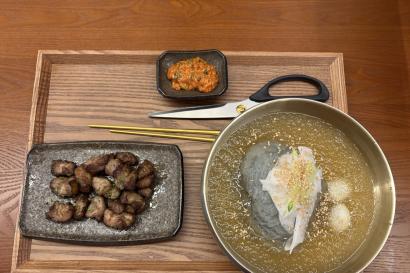Anybody who has been to music school is likely familiar with the term “concert black”. It’s a term used to describe all black formal dress used for a cultivated music concert. Students in classical or jazz music are likely forced to wear concert black for concerts in an academic setting. As a music student at Ithaca College, I have always loathed concerts black. I think it is very uninspiring and makes the visual aspect of a concert dull. In Seoul however, performers have been able to get away with wearing almost anything on stage. Not only that but they are able to use their sometimes questionable fashion choices to enhance their performance.
- The Sneakers
Behind my apartment there is a Jazz club called Sounddog. Upon discovering it I went there every night for a week to see the band. While every band presented a very fresh and “Koreanized” take on Jazz the real eye catching thing was that at least one performer per night would be wearing the same shoes as me. I have one pair of Nike Air Force ones that I wear pretty much everywhere I go. Yet here these Jazz musicians played very cultivated music in dirty sneakers. This seemed oddly appropriate. The venue is very small and lacks a stage so the performers are always in your face. The casual dress mixed with very Korean inspired Jazz was very fitting overall.
- The Bright Shirts
One of my favorite places to see live music is a club South of Hongdae street called Jebidabang. This is a small venue that hosts a real menagerie of acts. Last weekend I saw a duo of violin and classical guitar. The music was diverse ranging from Irish folk songs like “Go Lassie Go” to Astor Piazzola’s “Cafe 1930”. The latter of which I had seen performed at Ithaca College. When I saw this piece performed at Ithaca it was performed at a very high level and was played almost perfectly. The Jebidabang performance was far from perfect technically but was far more enjoyable overall. The small home-like atmosphere, with chairs that belong in a dining room, and bookshelves filled with books classic to a younger generation. It certainly was more exciting than Ithaca college's generic concert halls. The Audience also was much more engaged. In the United States we always equate music that is familiar with music that is good. We get excited to hear a live band play our favorite songs and we grow bored when we are hearing music that is unfamiliar. Koreans don’t have this same mindset when it comes to live music. The prospect of explaining where a piece of unfamiliar music came from and then playing it goes over a lot better. “Cafe 1930” is a piece of music that likely only I and the performers were familiar with. However, the audience still smiled, as they sipped on their drinks, and chatted quietly chatting with their friends. While the Ithaca College performance was very dry and demanded silence from the audience, Jebidabang let the audience be as engaged as they wanted in the music. And to top it all off they were in some of the most casual clothes I have ever seen on stage. The violinist wore a striped oversized sweater while the guitarist wore an oversized neon orange t-shirt. While a little outlandish it definitely helped create a very relaxed atmosphere for the audience.
- The Hanbok
Korean Traditional Music poses one of the most striking examples of how dress can affect music. One of my favorite traditional styles is “Sanjo," which is a solo instrument accompanied by a lone drummer (or Janggu). I have seen many Sanjo performances featuring the Gayageum, a traditional zither. The performances are strikingly similar to a concert at Ithaca College. Everybody claps when the performer walks in, the performer bows, then the performer proceeds to spend way too much time setting up and tuning while the audience sits and waits. However, while the average Ithaca College student comes out dressed like a formal stage crew member, the Sanjo performer comes out in Traditional Hanbok. Their dress makes me feel more immersed in the performance and makes the music feel more authentic. Gayageum is a difficult instrument to listen to. The Sound is very simple yet foreign to a lot of listeners and Sanjo performances can be up to an hour long. However, seeing the performer in Hanbok and sharing this music how it was intended to be played makes me more open to hearing new sounds.

Harry Pogorzelski-Ponichtera
My name is Harry Pogorzelski-Ponichtera and I am currently a music composition major at Ithaca College. I have been playing guitar since I was 7 years old. In my spare time I enjoy making music and gaming with friends!







